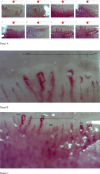Multifactorial Induction of a "Scleroderma-Like Pattern" Without Underlying Connective Tissue Disease: Diagnostic and Therapeutic Implications
- PMID: 39739183
- PMCID: PMC11685844
- DOI: 10.1002/acr2.11784
Multifactorial Induction of a "Scleroderma-Like Pattern" Without Underlying Connective Tissue Disease: Diagnostic and Therapeutic Implications
Erratum in
-
Correction to "Multifactorial Induction of a "Scleroderma-Like Pattern" Without Underlying Connective Tissue Disease: Diagnostic and Therapeutic Implications".ACR Open Rheumatol. 2025 Apr;7(4):e70028. doi: 10.1002/acr2.70028. ACR Open Rheumatol. 2025. PMID: 40210603 Free PMC article. No abstract available.
Abstract
A 60-year-old man with a significant 20-year history of smoking, averaging approximately 20 cigarettes per day, presented with type 2 diabetes mellitus, hypercholesterolemia, and hypertension. Over the preceding three months, the patient reported recurrent episodes of acrocyanosis and erythema of the hands that were primarily induced by cold exposure. A capillaroscopy conducted in November 2024 revealed a "scleroderma-like pattern" that was characterized by enlarged capillaries, megacapillaries, and a capillary density of fewer than eight capillaries per millimeter. Comprehensive immunologic and instrumental assessments demonstrated no evidence of systemic involvement or autoimmune disease. This case emphasizes the need to recognize the substantial role of cardiometabolic risk factors, including smoking, diabetes, hypertension, and hypercholesterolemia, in contributing to capillaroscopic abnormalities that may mimic systemic sclerosis. In this patient, the cumulative impact of these cardiometabolic factors culminated in the establishment of an "scleroderma-like pattern" observed on nailfold capillaroscopy.
© 2024 The Author(s). ACR Open Rheumatology published by Wiley Periodicals LLC on behalf of American College of Rheumatology.
Figures

Similar articles
-
Lithium and smoking-associated scleroderma-like pattern in a 18-year-old patient: a case report.Intern Emerg Med. 2025 May 18. doi: 10.1007/s11739-025-03973-9. Online ahead of print. Intern Emerg Med. 2025. PMID: 40382751
-
Nailfold capillaroscopy in systemic diseases: short overview for internal medicine.Rom J Intern Med. 2021 Aug 26;59(3):201-217. doi: 10.2478/rjim-2021-0007. Print 2021 Sep 1. Rom J Intern Med. 2021. PMID: 33600677 Review.
-
Nailfold capillaroscopy abnormalities and pulmonary hypertension in mixed connective tissue disease and systemic sclerosis patients.Eur Rev Med Pharmacol Sci. 2024 Feb;28(4):1314-1326. doi: 10.26355/eurrev_202402_35453. Eur Rev Med Pharmacol Sci. 2024. PMID: 38436165
-
Nailfold capillaroscopy is useful for the diagnosis and follow-up of autoimmune rheumatic diseases. A future tool for the analysis of microvascular heart involvement?Rheumatology (Oxford). 2006 Oct;45 Suppl 4:iv43-6. doi: 10.1093/rheumatology/kel310. Rheumatology (Oxford). 2006. PMID: 16980724 Review.
-
The Value of Nailfold Capillaroscopy in the Classification and Differential Diagnosis of Raynaud's Phenomenon in Rheumatology.Curr Rheumatol Rev. 2024;20(2):108-114. doi: 10.2174/1573397119666230905151903. Curr Rheumatol Rev. 2024. PMID: 37691224
Cited by
-
Correction to "Multifactorial Induction of a "Scleroderma-Like Pattern" Without Underlying Connective Tissue Disease: Diagnostic and Therapeutic Implications".ACR Open Rheumatol. 2025 Apr;7(4):e70028. doi: 10.1002/acr2.70028. ACR Open Rheumatol. 2025. PMID: 40210603 Free PMC article. No abstract available.
References
-
- Cutolo M, Smith V. Detection of microvascular changes in systemic sclerosis and other rheumatic diseases. Nat Rev Rheumatol 2021;17(11):665–677. - PubMed
-
- Yuksel EP, Yuksel S, Soylu K, Aydin F. Microvascular abnormalities in asymptomatic chronic smokers: a videocapillaroscopic study. Microvasc Res 2019;124:51–53. - PubMed
-
- Ciaffi J, van Leeuwen NM, Huizinga TWJ, et al. Smoking and systemic sclerosis: influence on microangiopathy and expression of anti‐topoisomerase I antibodies in a monocentric cohort. Clin Exp Rheumatol. 2020;38(3):25–28. - PubMed
-
- Andrés EÁ, de Miguel E, de Yébenes MJG, et al. Relationship between nailfold videocapillaroscopic findings and cardiovascular risk factors. Microvasc Res 2024;154:104693. - PubMed
Publication types
LinkOut - more resources
Full Text Sources

